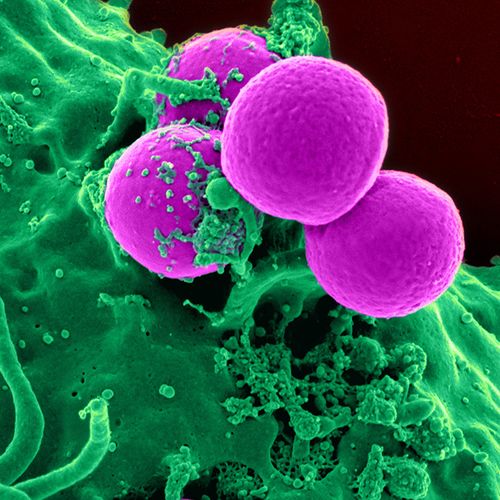A "nightmare" bacteria that is resistant to powerful antibiotics and kills half of those it infects has surfaced in nearly 200 US hospitals and nursing homes, according to the US Centers for Disease Control and Prevention (CDC).
The CDC said 4% of US hospitals and 18% of nursing homes had treated at least one patient with the bacteria, called Carbapenem-Resistant Enterobacteriaceae (CRE), within the first six months of 2012 and that number increased in 2013.
CRE are in a family of more than 70 bacteria called enterobacteriaceae, including Klebsiella pneumoniae and E. coli, that normally live in the digestive system.
In recent years, some of these bacteria have become resistant to last-resort antibiotics known as carbapenems.
"CRE are nightmare bacteria. Our strongest antibiotics don't work and patients are left with potentially untreatable infections," CDC Director Thomas Frieden MD, MPH, said. "Doctors, hospital leaders and public health (officials) must work together now to implement the CDC's detect and protect' strategy and stop these infections from spreading."
Better Cure for C. Diff Infection
Clostridium difficile (C. diff), a dangerous bacterial infection that causes severe diarrhea, sometimes is difficult to treat with antibiotics and/or probiotics.
Recent study: When researchers implanted donated human stool from healthy family members into the intestines of 49 patients (average age 66) with C. diff, all of the patients recovered dramatically within four days, with no recurrence within the 100 days following treatment.
Theory: Healthy stool contains good bacteria that reestablish normal intestinal flora.
If you have C. diff that has not responded to antibiotics or probiotics: Ask your doctor about a fecal transplant.
"The good news," Dr. Frieden added, "is we now have an opportunity to prevent its further spread." But, he continued, "We only have a limited window of opportunity to stop this infection from spreading to the community and spreading to more organisms."
Although CRE bacteria are not yet found nationwide, they have increased fourfold within the United States in the past decade, with most cases reported in the Northeast.
Health officials said they're concerned about the rapid spread of the bacteria, which can endanger the lives of patients and healthy people. For example, in the last 10 years, the CDC tracked one CRE from one health-care facility to similar facilities in 42 states.
One type of CRE, a resistant form of Klebsiella pneumoniae, has increased sevenfold in the past decade, according to the CDC's 5 Vital Signs report.
"To see bacteria that are resistant is worrisome, because this group of bacteria are very common," said Marc Siegel, MD, clinical associate professor of medicine at NYU Langone Medical Center in New York City.
Who Gets CRE And How It Spreads
Most CRE infections to date have been in patients who had prolonged stays in hospitals, long-term facilities and nursing homes, the report said.
The bacteria kill up to half the patients whose bloodstreams get infected and are easily spread from patient to patient on the hands of healthcare workers, the CDC said.
Moreover, CRE bacteria can transfer their antibiotic resistance to other bacteria of the same type.
This problem is the result of the overuse of antibiotics, Dr. Siegel said. "The more you use an antibiotic, the more resistance is going to emerge," he said. "This is an indictment of the overuse of this class of antibiotic."
What's needed are new antibiotics, Dr. Siegel said, adding that pharmaceutical companies lack the financial motivation to develop them right now.
"Eventually, there will be enough resistance so drug companies will have a financial incentive. In the meantime, lives can be lost," he said.
"At this time, our best prevention is detection and infection control. The incidence (of CREJ is low and we are looking to prevent it before it gets much higher and we cannot control it," commented Ghinwa Dumyati, MD, associate professor of medicine at the University of Rochester in New York.
Wipe Off the Top
Wipe off the top of a soda can, or rinse it with water, before drinking from it. Cans of soda bought at stores and from machines carried a variety of bacteria on the tops. Cans bought from stores and gas stations had the most germs...those from vending machines had fewer...those bought in 12-packs had the fewest.
To beat back the spread of these bacteria, the CDC wants hospitals and other health-care facilities to take the following steps…
- Enforce infection-control precautions.
- Group together patients with CRE.
- Segregate staff, rooms and equipment to patients with CRE.
- Tell facilities when patients with CRE are transferred.
- Use antibiotics carefully.
Additional funding of research and technology is critical to prevent and quickly identify CRE, the CDC said.
Hospitals Can Control CRE
Countries where CRE is more common have had some success controlling it.
Israel, for example, worked to reduce CRE in its 27 hospitals, and CRE rates dropped by more than 70%. Some US facilities and states have also seen similar reductions, the agency said.
"We have seen in outbreak after outbreak that when facilities and regions follow the CDC's prevention guidelines, CRE can be controlled and even stopped," said Michael Bell, MD, acting director of the CDC's Division of Healthcare Quality Promotion. "As trusted health-care providers, it is our responsibility to prevent further spread of these deadly bacteria."
What Patients Can Do
Dr. Siegel said there are measures patients can take to reduce their risk of infection.
"Number one on the list is to not push for a longer hospital stay. Patients think they are safer at the hospital, but that may not be true," he said. "And try to go into a clean hospital."
Patients should also make sure doctors and staff wear gloves and wash their hands when treating them, he said.
